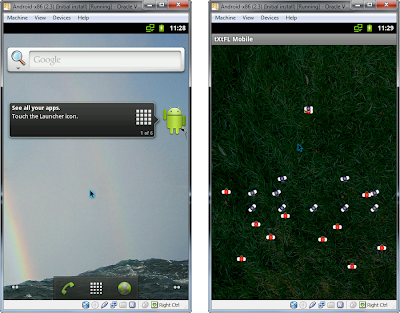Install Notes: Fedora 7 on Dell 700m
Networking on my work laptop of 2 years has been having issues, so I decided to wipe the drive and replace WinXP with Fedora 7. I have a standard Dell 700m laptop. Some notes from my installation/configuration experience:
- Installation: Fedora 7 installed without a hitch. I downloaded the live CD, which boots into a fully operational version of Fedora for using and testing. I clicked a desktop icon for installation to the hard drive, which apparently copied an entire disk image, without having to choose which individual packages to install, as in past Fedora installations.
- First boot: Almost every basic function worked out of the box. Even wireless was up and running without special configuration. One noticeable shortcoming however was the screen resolution. It was set to a standard resolution of 1024x768, even though my laptop has a widescreen 1200x800 display. Going to the Screen Resolution configuration utility, I had no widescreen option.
I read on another blog that the problem could be fixed by installing something called 915resolution, where 915 refers to the Intel 915 chip. The Dell 700m laptop actually has an Intel 855 chip, whose driver was installed by default, but the new 915 driver seems to work better. To install, I opened a terminal and (as root) ran yum install 915resolution. I next edited the file /etc/sysconfig/915resolution with the line RESOLUTION="7e 1280 800". After restarting the X server (logging out and back in), widescreen was up and running. - Suspend/hibernate: I first tried hibernate options, to no avail. Some blogs have posted success using swsuspend2 on Dell 700m laptops, after some configuring. My experience has been that the screen resolution keeps returning to 1024x768 (non-widescreen), although everything else seems to work from cursory examination.
A new database of quirks has been created in preparation for Fedora 8 to show tips on getting suspend/hibernate and other functions working on specific laptops. From running a quirks script I found there, I learned to replace the i810 driver with the intel driver. I changed drivers through System > Administration > Display > Hardware > Video Card, where I picked intel, as advised by the Fedora 7 release notes.
After switching to the new driver and making the configuration updates for swsuspend2, I tried the built-in Hibernate mode, which I think uses swsup included in the default kernel. It worked! Even widescreen and wireless resumed, although I haven't checked much more. - Virtualization: Fedora has been providing virtualization support through Xen for quite some time, continually adding new features. I had a good experience with another vendor, however, a company by the name of Innotek that has released a virtualization software called Virtual Box for Windows, Linux, and MacOS. All versions are open source and free for download, with additional licensing requirements only for large enterprise users. Guest additions for a Fedora guest have worked out of the box for both my Windows Vista and XP hosts. I wanted to see if installation in the reverse direction--WinXP guest on a Fedora Linux host--might work as seamlessly.
Virtual Box recently released v.1.5.0. I downloaded the latest copy (for free) and installed it on Fedora. WinXP Pro installed without issue, and I installed Guest Additions. v.1.5.0 introduced a new features called Seamless mode, where the Windows windows are each treated as another window in Linux, with the toolbar built into the bottom of the screen. This is an improvement from normal modes, where the whole Windows desktop would be contained in a separate window, with smaller Windows windows inside. Enough "windows" to deal with, eh?
One hitch was that the Shared Folders feature wasn't working from the start, so I couldn't read files from Linux on Windows. I had to manually transfer each file I wanted to read or write. Following advice from a Virtual Box forum, I removed the shared folder --> uninstalled the Additions --> rebooted --> reinstalled Additions --> rebooted --> re-added the shared folder, and now I can read/write files in Windows from Linux. I'll keep watching to see if it keeps working. - SD card reader: Linux detected a 512 MB SD card I inserted into the built-in SD reader and asked if I wanted to import the photos. I chose to read the card directly, as I read it in Windows, but the card sporadically disconnected and reconnected. I transfered one file, but the whole computer locked up when trying to open it directly from the card. Perhaps a kernel issue?
- Compiz: Desktop Effects looks quite nifty, what with the wobbling windows, spinning workspaces on a cube, and bendable windows. I unfortunately experience window blackout issues with Desktop Effects plus Virtual Box Seamless mode, so I've switched off the Effects for now.


Comments